New Perspectives on Energy Efficiency and Sustainability: Integrating the Updates from the New F-Gas Regulation (REGULATION (EU) 2024/573)
The entry into force of the new Regulation (EU) 2024/573 (F-Gas) marks a pivotal milestone in the HVAC and Refrigeration sectors. Rather than viewing this regulation as a barrier, it is crucial to understand it as a renewed scenario where non-fluorinated refrigerant technologies emerge as key players. The sectors involved will need to take a step forward in training and specialization, retraining themselves, and setting new work guidelines. However, the new F-Gas brings both lights and shadows. Lights in what it has already imposed, but shadows in what remains undefined, leaving uncertainty for those of us who have thoroughly reviewed the Regulation. In this article, we will outline, without being exhaustive, these lights and shadows, leaving time to answer the questions raised.
The certainties are:
- Fluorinated Gases Portal Individuals working with F-GEI will be divided into three groups:
- Accredited Individuals
- Certified Individuals
- Certified Legal Entities The responsibilities of each group are clearly defined.
- Classification of F-GEI (Fluorinated Greenhouse Gases) This has been modified by the introduction of new F-GEI, including fluorinated substances used as inhalation anesthetics and fluorinated ethers, ketones, and alcohols. The impact of introducing these new gases is still undefined, as we do not yet know the quantities of these products on the market.
- Maximum Amounts of F-GEI on the Market The quantities have been significantly reduced compared to the previous version, with a very restrictive outlook for the period from 2033 onward. The reductions proposed for the periods are:
- 2025 – 2026: -21.73%
- 2027 – 2029: -48.91%
- 2030 – 2032: -75.39%
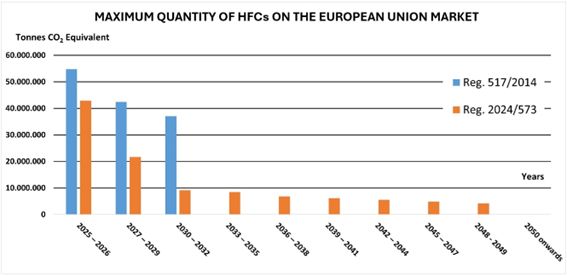
- Leak Detection Schedule Previously based on CO2-equivalent tons contained in the equipment, a new criterion has been added, considering the gas load in kg.
- Market Introduction Ban Schedule Undoubtedly, the most anticipated aspect, as it sets the playing field for the coming years. Presented in a segmented manner by equipment type, the established dates are:
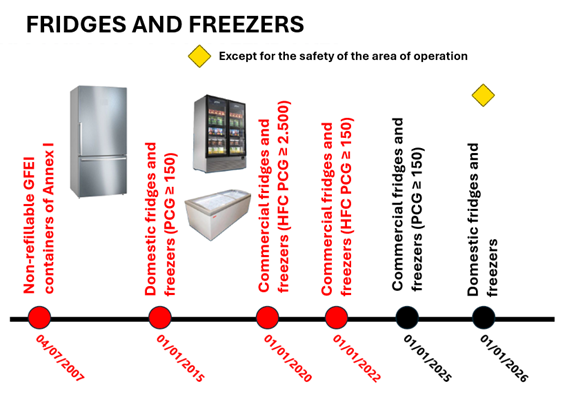
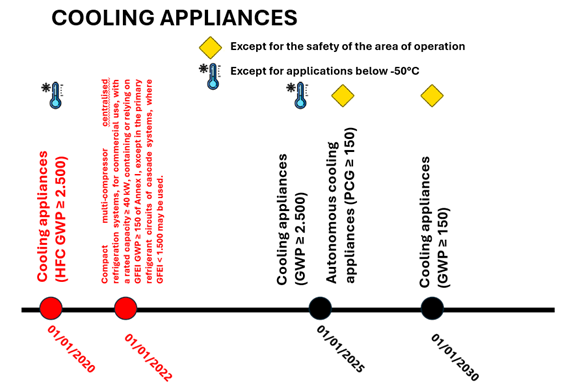
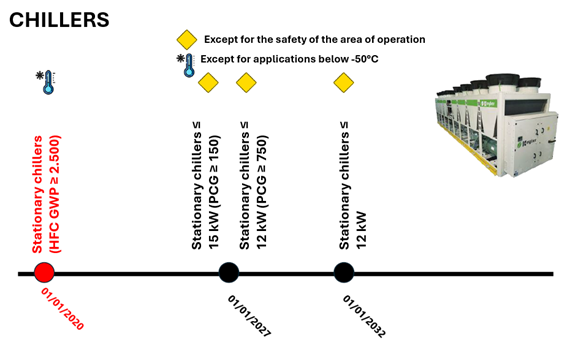
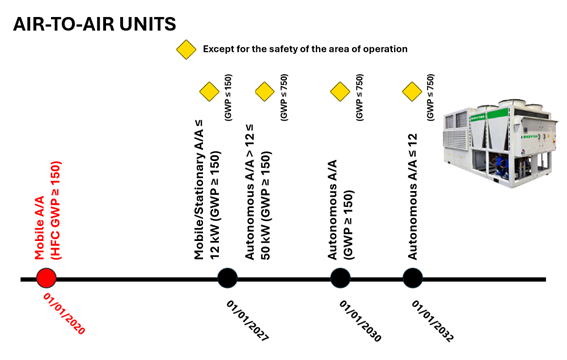
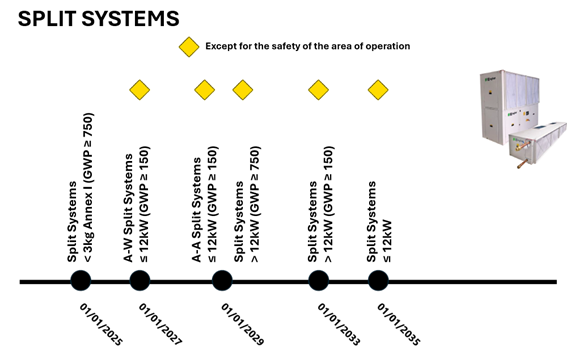
- Controls Competent authorities in Member States will conduct checks to determine if companies are complying with their obligations under the Regulation through on-site inspections, document and equipment verification, and online platform checks.
- Sanctions Ranging from monetary fines to confiscation, seizure, or withdrawal of the product from the market, and even the temporary prohibition of use, production, import, export, or market introduction.
- Modifications to Current Regulations The introduction of F-Gas necessitates, though indirectly, the modification of the Refrigeration Installations Safety Regulation (RSIF). The new GWP limits it establishes must be adopted, the introduction of flammable Type 3 refrigerants in some environments must be regulated, installer levels must be reviewed, and so on. Many aspects have been indirectly impacted by this modification and must be addressed in a short period. Not only must the Regulation be modified, but it must also be applied and the limits it establishes respected more strictly. Refrigerant charge limits in equipment must be carefully considered, and the location of these units must be selected more cautiously. Concepts such as “ventilated enclosure,” defined as “an enclosure housing refrigeration systems where controlled ventilation maintains lower pressure inside compared to surrounding spaces, preventing refrigerant from escaping outside the enclosure,” will become part of daily operations. The tables in Appendices 1, 2, and 3 of RSIF’s IF-04 must now be read with a new perspective, gaining prominence over installations with Type A1 F-GEI, which previously had very few restrictions. Machine Rooms will now, in fact, be Specific Machine Rooms. The language of installations has changed, and for this, I recommend reading Article 3 of the new F-Gas, where many new terms have been introduced.
- Sector Reorientation While we had already been preparing for the upcoming changes, the acceleration of these changes was somewhat unexpected. The effort to realign will be intense and will require significant changes in the strategies of various actors in the HVAC and refrigeration sectors. Engineers and Installers will now need to advise property owners not only on the most suitable type of installation for their needs but also on the type of refrigerant to use—a new concept that was not always considered before.
The uncertainties are:
- Fluorinated Gases Portal Through this communication channel, not yet established, documentation will be required for Market Introduction, F-GEI Production, Imports, Exports, Destruction, Use as Raw Material, Recovery, Regeneration, etc. An ambitious project linked to the European Union Customs Single Window Certificates Exchange System (EU CSW-CERTEX), established under Regulation (EU) 2022/2399.
- Training The content of Certification and Accreditation Programs must be prepared by March 2025, approved by 2026, and launched in 2027. Additionally, professionals must be recertified every seven years. Some involved parties are viewing this as a negative, given the requirement for additional training for current sector professionals. However, this should be seen as an opportunity for professional, technical, and market niche growth, as the new technologies accompanying refrigerants like R-290, R-717, and R-744, among others, open doors to sectors previously inaccessible to Heat Pumps. Generating domestic hot water, producing high-temperature hot water, or even supplying steam in industrial settings, were horizons not considered just a few years ago, and now they are a reality.
- Regeneration It is stipulated that F-GEI must be regenerated by Authorized Regeneration Centers, entities that have yet to be defined.
The new regulations establish a paradigm that challenges us to respond with agility and strategic vision. At KEYTER, in our commitment to innovation and sustainability, we view this new scenario as an opportunity to offer innovative solutions that not only meet the requirements but go beyond, delivering efficiency and environmental responsibility. One of our key offerings is ZIRAN Pro, reversible air-to-water Heat Pumps from KEYTER’s PRO series. An optimized solution for R290 and Full-Inverter Technology to achieve exceptional performance in HVAC systems for commercial, industrial, and centralized residential applications. With ZIRAN Pro, we not only comply with the new regulations but also lead the way toward a cleaner and more efficient future. This technology not only offers outstanding energy efficiency but also significantly reduces our carbon footprint, thus contributing to environmental protection.
The path to full compliance and leveraging the opportunities presented by the new regulations is challenging. However, at KEYTER, we are committed to overcoming these challenges with efficient, sustainable, and reliable solutions tailored to the needs of each project. In addition to our service from equipment selection to commissioning, we are currently advising those who trust us to choose long-lasting solutions. The uncertainties posed by this new landscape, from required documentation to professional training, challenge us to innovate and grow. At KEYTER, we are ready to face these uncertainties with determination and leadership, turning each obstacle into an opportunity for growth and service to our clients.
More articles
Interested in other (technical) knowledge articles? Keep yourself up to date and read them all

